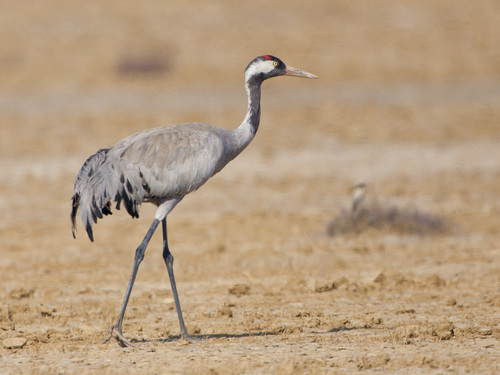
Common Crane
The Common Crane (Grus grus) is a large, elegant bird renowned for its impressive migrations and elaborate courtship dances. It plays a significant role in many cultures, symbolizing longevity, good fortune, and vigilance. Ecologically, Common Cranes are important indicators of wetland health, as they rely on these habitats for breeding and foraging. They are one of the largest birds in Europe and have fascinated people for centuries, appearing in folklore, art, and literature.
100-130 cm
Length
200-240 cm
Wingspan
Least Concern
Conservation Status
Distribution
Breeds across northern Europe and Asia, from Scandinavia and eastern Germany to Siberia and northern China. Winters in southern Europe, North Africa, the Middle East, and parts of Asia, including India and Southeast Asia. Migratory routes are well-defined and often cover thousands of kilometers.
Lifespan
Up to 30-40 years in the wild, although many do not survive their first year.
Common Crane's Habitat
Habitat Types
Bogs, Marshes, Wet meadows, Floodplains, Shallow lakes
Climate Zones
Temperate, Boreal, Subarctic
Adaptations
Long legs and neck allow for wading in shallow water and foraging in tall vegetation. Their strong bills are adapted for probing in mud and soil for food.
Variations
Two recognized subspecies: *Grus grus grus* (western populations) and *Grus grus lilfordi* (eastern populations). Differences are subtle, primarily involving slight variations in size and plumage coloration.
Appearance
Breeding Plumage
Adults have primarily grey plumage. During breeding season, they may stain their feathers with mud and vegetation, giving them a brownish appearance. Non-breeding plumage is generally a cleaner grey.
Seasonal Feather Changes
See above (breeding vs. non-breeding). Juveniles have brownish plumage and lack the red crown patch of adults.
Sex Based Plumage Differences
Minimal; males and females have similar plumage.
Notable Features
Red crown patch on the head, Long, black neck with a white stripe extending down the side, Bushy 'bustle' formed by elongated tertial feathers
Diet and Feeding
Primary Foods
Plant roots, Tubers, Seeds, Grains, Insects, Small vertebrates (frogs, rodents)
Foraging Behavior
Forages by walking slowly and probing the ground with its bill. Will also glean food from the surface and occasionally dig for roots and tubers.
Specializations
The long bill and neck are well-suited for probing in soft soil and shallow water.
Seasonal Diet Variations
Diet varies depending on food availability. During breeding season, they consume more insects and small animals. In winter, they rely more on grains, seeds, and agricultural crops.
Behavior
Social Structure
Forms large flocks during migration and in wintering areas. During breeding season, they are territorial and defend their nesting sites.
Communication
Loud, trumpeting calls (used for long-distance communication and pair bonding), Visual displays (dancing, bowing, wing flapping)
Migration
Migrates in large flocks, often flying in V-formations. They use traditional routes and stopover sites. Migration is triggered by changes in day length and weather conditions.
Territorial or Group Behaviors
Highly territorial during breeding season. Outside of breeding season, they are gregarious and form large flocks.
Conservation
Threats
Habitat loss and degradation (due to drainage of wetlands, agricultural expansion, and urbanization), Collision with power lines, Hunting (in some parts of their range), Climate change (affecting breeding and wintering habitats)
Protection Programs
International agreements (e.g., the African-Eurasian Migratory Waterbird Agreement (AEWA)), Habitat restoration and protection projects, Monitoring and research programs
Local National Laws
Protected under various national laws in many countries across its range.
Population Trend
Increasing
Population Estimates
Global population estimated to be around 400,000-470,000 individuals.
Interesting Facts
They are one of the loudest bird species.
Their calls can be heard for several kilometers.
They can fly at very high altitudes during migration.
They have been recorded flying at altitudes of up to 10,000 meters (33,000 feet).
They mate for life.
Pairs typically stay together for many years, reinforcing their bond with elaborate courtship displays.
Faqs about Common Crane
What is the difference between a crane and a heron?
Cranes are generally larger than herons and have a more upright posture. Cranes fly with their necks outstretched, while herons fly with their necks retracted in an S-shape. Cranes also have a more elaborate courtship dance.
Where can I see Common Cranes?
Look for them in wetlands, marshes, and agricultural fields during their breeding and wintering seasons. Many nature reserves and birdwatching sites offer opportunities to observe migrating flocks.
Are Common Cranes endangered?
No, they are currently classified as 'Least Concern' by the IUCN, but they still face threats from habitat loss and other factors.
Copyright @ Nature Style Limited. All Rights Reserved.
 English
English